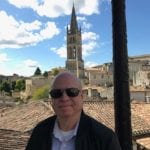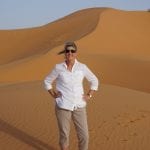Southern Africa Sojourn – Part 2
I traveled on African safari with my safari buddy, Susannah. From Cape Town we flew to Johannesburg, then to Maun, Botswana, where we were met and took off on light aircraft for our first stop, Mombo Camp.
Mombo is in the Moremi Game Reserve, on the northern tip of Chief’s Island. Mombo has nine tents raised off the ground on wooden platforms connected by walkways. Spacious, well designed, huge en suite bathrooms with inside and outside showers, long verandas, excellent views.
The camp’s bar, library and main gathering area are under thatch, some of the dining is al fresco. There are two plunge pools and a fitness tent, however the pools are not heated.
The best feature of Mombo is the game viewing. It is just amazing – we saw so many elephants, giraffes, and lion! We found a group of lioness lounging and sleeping on the drive from the airstrip. Later that evening we practically stumbled (in our vehicle) upon the male! He walked around a large shrub as we were driving around the other side – suddenly there he was! The next morning we found the cubs, playing and quite well fed by 2 mothers, who traded off the duty of feeding them. We spotted so many animals as well as beautiful birds – I never cared much about birds until my first trip to Zambia – now I find them so interesting! Mombo is a world reknowned camp – with good reason. It is a very special place.
After an evening game drive, lovely dinner and overnight, great morning game drive, we headed back to the airstrip and took off for Vumbura Plains, in the Okavango Delta. Vumbura has two camps totaling 14 rooms, with Little Vumbura a short drive away. There are two family accommodations, one of which we stayed in. This was set up with one entrance onto a wooden deck with plunge pool and seating area, with the main room on one side, the second room on the other.
My room was elegantly designed with a step down lounge area, large bed, a huge indoor shower as well as an outdoor shower, The second room was smaller but also very well designed. The common area was built with raised lounge and dining areas, and decks with cushions jutting out over the floodplains for both game viewing by day and star gazing at night.
This camp offers both land and water activities. Since we had limited time, we asked to be on the water as much as possible.
After lunch, before heading out, we had time for a rest on our own deck beside our own plunge pool. As we were dozing on our lounge chairs, we heard the crashing of bushes – we jumped up as an adolescent elephant came walking right beside our deck – he gave us quite a look as he passed close to our pool. I think he wanted to stop and take a drink, but he was irritated with our presence. It was quite a thrill to see him walk to close. We were assured the Ellies will not come up on the decks but he was awfully close!
Also at Vumbura, there are raised wooden walkways. However since the elephants like to walk from the water to the land across a couple of specific areas they were continually breaking the walkway. Now there are two spots where the walkway goes down to the ground as these are the “elephant crossing” spots. We had to wait several times while elephants were walking through, before we could continue to our room.
We then had a magical afternoon spent on a motorboat out on the Delta, speeding across the clear water, through the reed channels. We saw hippo, crocodile, lechwe (antelope which live where there is water) and wonderful birds. We felt incredibly lucky to be able to experience this – zipping along in the boat among the “streets” made of reeds, turning a corner and into another maze. We stopped to enjoy sundowners on the boat and watched an amazing sunset – the reflection of light on water made it hard to tell where the sky stopped and water started – it looked as if we were floating in the sky.
We made a stop at Little Vumbura to see the other camp which is charming – not as elegant as the main camp, but so friendly.
That night we saw the Milky Way which looked as close as I’ve ever seen it – breathtaking.
The next morning we were off on the mokoro – originally dugout canoes carved from trees, now made from fiberglas in the interests of preservation. We glided silently along among lily pads and reeds, the water so clear we could see down to the bottom. There were frogs as small as my fingernail clinging to reeds – they make a very loud sound when they sing – for such tiny creatures.
We finally made our way back to camp to pack up. On the drive to the airstrip, we encountered a large bull elephant – quite angry as he was in musth, he was pretty angry as we carefully drove around him, giving lots of space.
We made it to the airstrip and were off to the next camp, Kings Pool, in the Linyanti Reserve bordering Chobe National Park. The camp is beautifully designed, overlooking a lagoon, nine tents with raised decks and plunge pool, indoor and outdoor showers, gorgeous views over the lagoon.
It had rained recently so the wildlife had dispersed, but we had a great time observing many giraffes as well as a family of baboons.
At Sundowners we met up with the other two vehicles so all the camp guests were together. We were served not only the usual appetizers, but also our first course while watching hippos play in a pool out in the bush.
Back to camp for dinner where we were met with martinis. Camp life in Botswana is quite luxurious – guests are well taken care of!
We flew out to Sandibe Okavango Safari Camp back in the Delta adjacent to Moremi, a new camp built to resemble a pangolin which is a very elusive African animal. The camp is beautifully designed – and it was the first camp we stayed in to offer wifi as well as air conditioning. Normally I enjoy being disconnected while on safari, but by now it was important for me to be able to check in, so I very much appreciated being able to connect.
We arrived at the airstrip for Sandibe – the other guests got into a vehicle for their transfer, but we had a special activity arranged. We were met by helicopter! The helicopter was equipped for a pilot and could hold three passengers, but we were only two.The doors were removed for better views.
We flew above the Delta for about 30 minutes – seeing elephants in family groups, raising their trunks to see what was up in the sky, We saw hippos running one after another in the waterways, We saw impala and other antelopes.
At one point we landed and were served champagne – with elephants in the field beyond, breathtaking scenery. Then we took off again – finally landing for our transfer to Sandibe, Incredible!
The location is lovely with floodplains and forest, lots of wildlife. We set out with ranger and tracker and successfully tracked a leopard! We had a fantastic time watching her as she finally climbed up into the notch of a tree and hung out up there as the sun was setting. It was just spectacular.
The next morning we had another great sighting – a pack of wild dog with their beautiful painted coats, as well as lots of hippo showing us how big their mouths can open, in an attempt to scare us away.
Our last camp was something different – Jack’s Camp in the Makghadigadi Pans in the Kalahari Desert. This is the place to come after one has seen the Big Five. The experience is extraordinary. There are three camps – Jacks, San Camp and Camp Kalahari. Jack’s and San Camp are similar with Moroccan design, antiques, communal dining, amazing settings. Jack’s Camp has a pool, colors are red fabric, beds are 4 poster.
There is no electricity, so lanterns light the tents in the evening. The camps have generators so guests always have hot water, there are indoor and outdoor showers. San Camp is all white – it faces the salt pans. As of now it is seasonal and closes in the wet season. They are discussing keeping it open all year but they need to build raised walkways as the area fills with water when it rains.
Camp Kalahari is more basic but also very comfortable. Simple tents, but all the same activities.
This is the place where the meerkats are habituated so the will climb up on guests and use them as lookouts. (a highlight of my trip – I had three meerkats sitting on my outstretched legs while several more used me as a backrest and leaned against me – their little chattering voices were so much fun to hear!) (no – you cannot touch them – they just climb up to make sure no predators are coming. They have a sentry who is always looking out to protect the group.)
There are ATV’s to ride into the desert, only with your guide or you will get lost. This happens only in the dry seasons as the ATV will sink when the pans are wet.
The San bushmen will walk with you and the few who speak English will translate their tales of life in the Kalahari. This is also a very special experience – we felt privileged to have this experience of hospitality. As we walked they would show us how they would trap a spring hare, or what plants were edible. They played a game to show us some of their culture. They dug up scorpions to show us, and talked about how they lived.
Guests can ride horseback in the salt pans during the dry seasons. During the wet season there is the other great migration with zebra, wildebeest and buffalo crossing the pans.
We saw a 5000 year old baobab tree which was used by the explorers such as Livingstone as a mailbox.
With a 3 night stay, you might spend one night under the stars, on a remote island tucked into your bed surrounded by a mosquito net.
Look for the brown hyenas, the aardvark, aardwolf, porcupine, etc. We saw them all, except for the brown hyena which we kept looking for.
There is a “meerkat whisperer” who stays out with the meerkats every day to keep them used to humans.
The landscape is endless – almost surreal. When out on the ATV’s we stopped – without the engines there is only the sound of the wind. There are no real landmarks so it is disorienting. Just beautiful.
The sky at night was huge. We were there at the best time of year according to our guide. May and June are excellent months, October is too hot.
As it was elsewhere in Botswana, the weather was cold at night, warm in the day. We would pull on lots of layers as we dressed in the morning to go out on safari. As the sun warmed us up, the layers would come off. It got up into the high 80’s during the middle of the day, down to the low 40’s in the evening. The evening game drives began at 4pm, still quite warm so we took our layers with us. By the time we had sundowners the layers all were back on. The vehicles carry warm ponchos, so we were never too cold.
We always had plunge pools at the camps, but the water never warmed up enough to dip in, it was always too cold. However, we did enjoy relaxing beside the pools when we had time.
Food at the camps was excellent, breakfasts made to order, dinners, lunches, tea time, sundowners – it is easy to overindulge.
Spending time anywhere on safari is always a wonderful experience, but Botswana has a special draw for me. The varied topography with the Delta, the amazing wildlife in pristine wilderness, all the activities one can experience here, the people one meets, ending on a high note with meerkats and bushmen – unforgettable.



